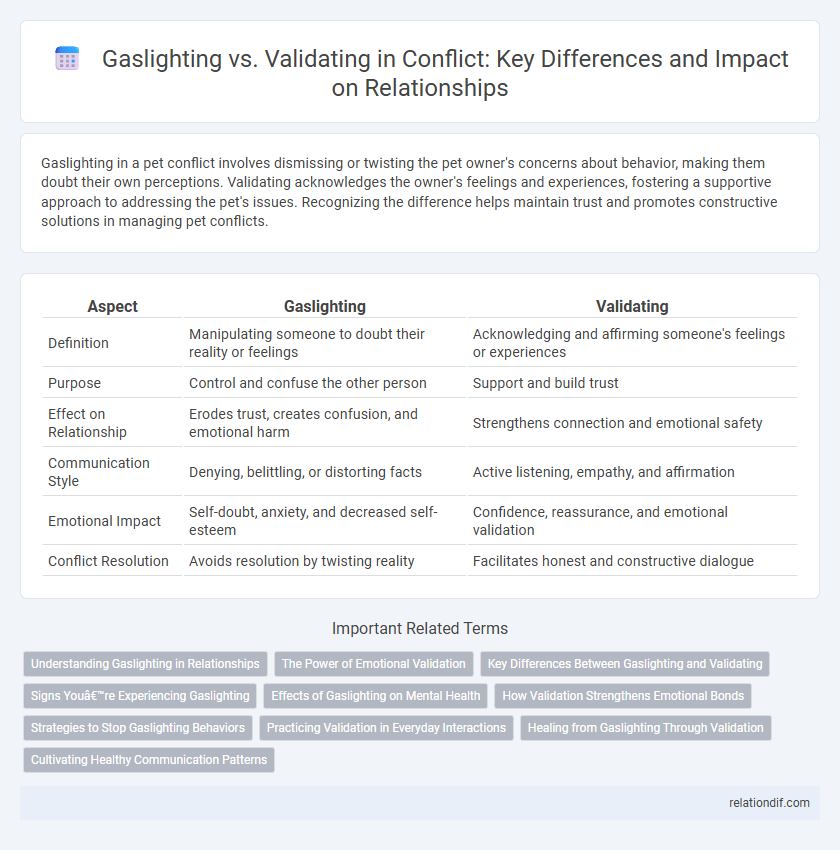Gaslighting in a pet conflict involves dismissing or twisting the pet owner's concerns about behavior, making them doubt their own perceptions. Validating acknowledges the owner's feelings and experiences, fostering a supportive approach to addressing the pet's issues. Recognizing the difference helps maintain trust and promotes constructive solutions in managing pet conflicts.
Table of Comparison
| Aspect | Gaslighting | Validating |
|---|---|---|
| Definition | Manipulating someone to doubt their reality or feelings | Acknowledging and affirming someone's feelings or experiences |
| Purpose | Control and confuse the other person | Support and build trust |
| Effect on Relationship | Erodes trust, creates confusion, and emotional harm | Strengthens connection and emotional safety |
| Communication Style | Denying, belittling, or distorting facts | Active listening, empathy, and affirmation |
| Emotional Impact | Self-doubt, anxiety, and decreased self-esteem | Confidence, reassurance, and emotional validation |
| Conflict Resolution | Avoids resolution by twisting reality | Facilitates honest and constructive dialogue |
Understanding Gaslighting in Relationships
Gaslighting in relationships involves manipulating a partner to question their memory, perception, or sanity, often causing severe emotional distress. Recognizing gaslighting requires awareness of tactics like denial, contradiction, and trivializing feelings, which erode trust and self-esteem. Validating a partner's experiences counters gaslighting by fostering empathy, support, and open communication essential for healthy relationship dynamics.
The Power of Emotional Validation
Emotional validation plays a crucial role in conflict resolution by acknowledging and affirming another person's feelings, which counters the harmful effects of gaslighting--a manipulative tactic that denies or distorts reality. Recognizing emotions as legitimate fosters trust and openness, empowering individuals to communicate more honestly and reduce misunderstandings. This psychological strategy strengthens relationships by promoting empathy and respect, essential components for resolving disputes constructively.
Key Differences Between Gaslighting and Validating
Gaslighting involves manipulating someone into doubting their own reality or feelings, often causing confusion and self-doubt, whereas validating acknowledges and respects a person's emotions and experiences as genuine. Gaslighting undermines trust and distorts perception, while validating promotes understanding and emotional support. The key difference lies in gaslighting's intent to control or deceive compared to validation's goal of fostering connection and empathy.
Signs You’re Experiencing Gaslighting
Constantly doubting your memories or feeling confused after conversations could be signs you're experiencing gaslighting in conflict. When your concerns are consistently dismissed as irrational or exaggerated, it erodes your sense of reality and self-trust. Persistent invalidation through denial of facts or minimization of feelings indicates manipulation aimed at undermining your perception.
Effects of Gaslighting on Mental Health
Gaslighting significantly undermines mental health by creating persistent self-doubt and confusion, leading to anxiety, depression, and diminished self-esteem. Victims often experience emotional exhaustion and difficulty trusting their perceptions, which can result in long-term psychological trauma. Validating experiences, in contrast, supports mental well-being by fostering a sense of reality and emotional safety.
How Validation Strengthens Emotional Bonds
Validation in conflict strengthens emotional bonds by acknowledging and affirming an individual's feelings, which fosters trust and openness in communication. Unlike gaslighting, which distorts reality and undermines self-esteem, validation promotes empathy and mutual respect, creating a supportive environment for resolving disputes. Consistent validation enhances emotional security, reducing defensive behaviors and encouraging collaborative problem-solving.
Strategies to Stop Gaslighting Behaviors
Recognizing gaslighting behaviors is the first step in implementing effective strategies to stop them, such as setting clear boundaries and seeking external validation from trusted sources. Empowering oneself through open communication and documenting interactions can disrupt manipulative patterns and reinforce personal reality. Professional support from therapists or counselors often plays a crucial role in breaking the cycle of gaslighting and promoting emotional resilience.
Practicing Validation in Everyday Interactions
Practicing validation in everyday interactions involves actively listening to others' feelings and experiences without judgment, which fosters trust and reduces conflict. Unlike gaslighting, which distorts or dismisses reality to manipulate, validation acknowledges emotions as real and important, promoting healthier communication. Incorporating techniques such as reflective listening and empathetic responses reinforces mutual respect and improves conflict resolution.
Healing from Gaslighting Through Validation
Healing from gaslighting requires recognizing and affirming one's experiences through consistent validation, which rebuilds trust in personal perceptions and emotions. Validation from trusted sources helps counteract the self-doubt and confusion imposed by manipulative behaviors, fostering emotional resilience and self-worth. Incorporating therapeutic techniques such as cognitive-behavioral therapy enhances the healing process by reinforcing accurate reality appraisals and personal empowerment.
Cultivating Healthy Communication Patterns
Gaslighting undermines trust by distorting reality and dismissing others' feelings, damaging healthy communication patterns in conflict resolution. Validating emotions fosters mutual respect and understanding, creating a foundation for constructive dialogue and empathy. Consistently practicing validation promotes psychological safety and strengthens relationships through honest and supportive exchanges.
gaslighting vs validating Infographic

 relationdif.com
relationdif.com